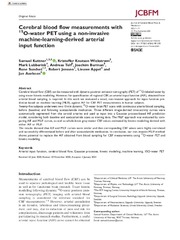Cerebral blood flow measurements with 15O-water PET using a non-invasive machine-learning-derived arterial input function
Permanent lenke
https://hdl.handle.net/10037/21469Dato
2021-02-08Type
Journal articleTidsskriftartikkel
Peer reviewed
Forfatter
Kuttner, Samuel; Wickstrøm, Kristoffer Knutsen; Lubberink, Mark; Tolf, Andreas; Burman, Joachim; Sundset, Rune; Jenssen, Robert; Appel, Lieuwe; Axelsson, JanSammendrag
Cerebral blood flow (CBF) can be measured with dynamic positron emission tomography (PET) of 15O-labeled water by using tracer kinetic modelling. However, for quantification of regional CBF, an arterial input function (AIF), obtained from arterial blood sampling, is required. In this work we evaluated a novel, non-invasive approach for input function prediction based on machine learning (MLIF), against AIF for CBF PET measurements in human subjects.
Twenty-five subjects underwent two 10 min dynamic 15O-water brain PET scans with continuous arterial blood sampling, before (baseline) and following acetazolamide medication. Three different image-derived time-activity curves were automatically segmented from the carotid arteries and used as input into a Gaussian process-based AIF prediction model, considering both baseline and acetazolamide scans as training data. The MLIF approach was evaluated by comparing AIF and MLIF curves, as well as whole-brain grey matter CBF values estimated by kinetic modelling derived with either AIF or MLIF.
The results showed that AIF and MLIF curves were similar and that corresponding CBF values were highly correlated and successfully differentiated before and after acetazolamide medication. In conclusion, our non-invasive MLIF method shows potential to replace the AIF obtained from blood sampling for CBF measurements using 15O-water PET and kinetic modelling.


 English
English norsk
norsk